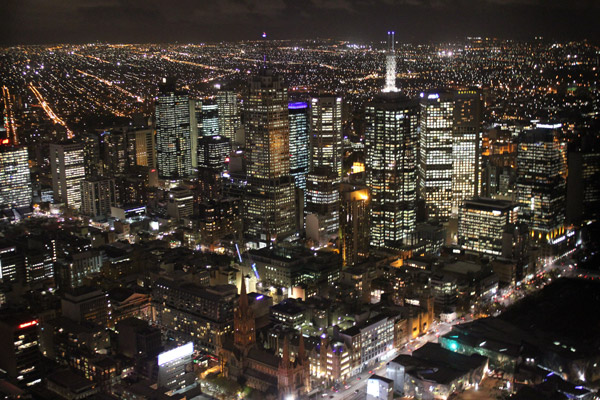Chris & Allyson vs. Australia (May 2012)
Day Nine: Goodbye to Cairns. Hello to Melbourne. Eureka Skydeck. Melbourne at Night.
We were done with Cairns as our ninth day in Australia began. Cairns wasn't done with us. Though we packed our bags for Melbourne and were ready to move on with our lives, we had half a day to make awkward small talk with Cairns and assure it we could totally still be friends. The important thing was not to backslide and sleep with Cairns again, because at that point you're looking at some serious airline change fees.
After our final breakfast at the Pacific International, Allyson and I aimlessly wandered the streets to see if we had missed anything. There weren't any major surprises, but it wasn't a waste of time. As we walked past the city government buildings, we came across trees contaminated with a few old friends: flying foxes.
They had seemed so exotic in Sydney, and the charm hadn't worn off. We watched them for a good 10 minutes as they ominously fluttered through the sky, and we hardly thought about the dreadful consequences if they decided to crap on us from above. It's impossible not to stare. They look like someone grafted demon wings to a plush toy.
We eventually found an indoor way to kill an hour. The Cairns Regional Gallery probably has a lot of slow days -- most people aren't coming to Cairns for the arts, and unlike Las Vegas, the city hasn't made most of its art events topless to account for that fact. But it's a nice-enough museum that features Australian artists.
Any vacation is improved by the viewing of regional art. All around the world, there are unknown talents toiling away at their craft, putting their unique local perspectives and experiences into their artistic creations. And everything they produce looks pretty much like the regional art you're going to see anywhere else in the world. We are one world, people.
None of the art we saw in Cairns rushes to the front of my mind, but I remember a gallery of work by illustrators of children's books. None of them had the range of Norman Lindsay, so there weren't any paintings of topless Valkyries doing jumping jacks on the back of a flying dragon. But it was still nice.
The highlight of the museum, for both Allyson and myself, was our smooth ride to the second floor, courtesy of the Switzerland-based Schindler elevator company. Of course, they need subsidiaries around the world to do maintenance work, and Australians don't refer to the product as an elevator. At the Cairns Regional Gallery, we rode a Schindler's Lift. It elevated us both physically and spiritually.
Our last stroll along the waterfront produced another wildlife encounter. Allyson and I were staring at the birds and crabs on the rocks at the end of the esplanade, when we saw some motion in the mudflats. Mudskippers were building their homes.
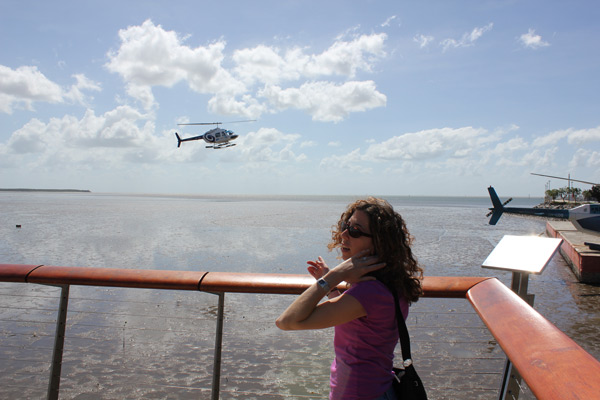
Get to the chopper! Our last moments in Cairns.
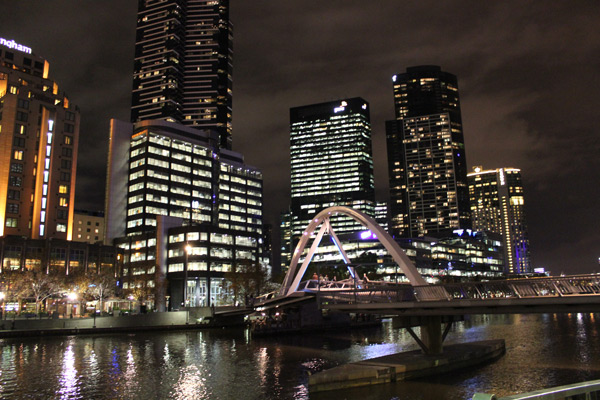
A stylish-looking bridge over the Yarra River.
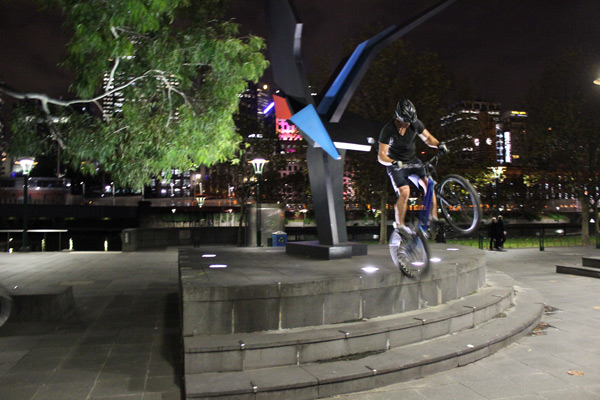
Melbourne: The city in love with fitness, even at night.

The approach to Eureka Tower.
The mudskipper is an awesome fish. They blast their pectoral fins when they hit the fish gym, which gives them the strength to crawl on land. And thanks to some very prudent evolution over the millennia, they can breathe air. They live in underwater burrows, which they build by scooping up mud in their mouths and dumping it elsewhere. We were watching them off-load. There were small circular puddles in the mud, and every few minutes a mudskipper would surface, swim over to the edge, and puke harder than a groupie who just woke up next to Keith Richards. By creating the puddle, they maintain a layer of water to protect them from predators when the tide goes out. There are always going to be some maintenance costs when you're a DIY contractor working with mud, but in this housing market we should all have such skills.
Just as nature's awesome miracle was starting to bore us, a helicopter appeared on the horizon and landed at the nearby marina -- probably on its way back from helping people puke things up on the Great Barrier Reef. It was a good reminder that we had to fly somewhere. We went back to the hotel, got our bags and caught the shuttle to the airport.
It was nice to enjoy the Cairns airport in the daylight, and in all its glory. There was a great sale at the surf shop, where I got two Billabong shirts at clearance prices. It is the uniform of the out-of-shape Australian male: a short-sleeve button-up with some kind of plaid pattern that's not baggy enough to hide your gut. The question was whether I'd get to wear it before our vacation was through. Cairns is tropical; Melbourne is 1,900 miles to the south -- about the distance from Washington, D.C., to Utah.
Let's get to know Melbourne, or as the Aussies call it, Melbin. It's in Victoria province. It was pretty much founded by a guy named -- seriously -- John Batman. Like Cairns, it grew thanks to a gold rush. Other than that, it's nothing like Cairns at all.
Melbourne is currently the second-biggest city in Australia, and it has all the complexes and attitudes that come with being the second-biggest city. Sydney gets all the attention, but the people of Melbourne believe that they have the substance. They view their city as more livable, more authentically Australian and way better at sports -- Melbourne is where Australian Rules Football was born, it's where the Australian Open is played, and it had the Olympics 44 years before Sydney. If you surveyed pothead international backpackers, Melbourne would top Sydney as their preference. It's cheaper, the public transportation seems easier to navigate and there's more free stuff to do.
The good people of Sydney mostly dismiss this as jealous bitching. It's not a uniquely Australian phenomenon. Science has proved that if you take two cities with roughly the same character and put them in relatively close proximity to each other, they will end up hating each other with the fury of a thousand suns. For example, the good folks of Pittsburgh and Cleveland aren't that far apart in character or history, but every time I visit my brother in Pittsburgh, we drive past a diner where a man was stabbed for wearing a Cleveland Browns jersey. When you put a story like that next to the Sydney-Melbourne dispute, it's a heartwarming reminder of the universal similarities that knit us together as a global community.
Our first on-the-ground encounter with a real Melburnian was at the airport. The shuttle driver was a large man who, in size and hairstyle, looked like Hurley from "Lost." He was endlessly conversational. We found out about the pitbull he didn't want to register with the government, and how his mom was doing, and how Melbourne was an awesome city. He told us how the produce at the Queen Victoria market was the freshest in the known universe, and that if we wanted a real meal, we needed to go find the Greek restaurants downtown. When a 300-pound man gives you a restaurant recommendation, pay attention.
Once again, the location of our hotel was ridiculous. Melbourne sits on Port Phillip Bay, and the Yarra River cuts through the city on its way there. In just about any city, fun stuff happens near the river. A body of water adds romance to any occasion and serves as an alternative getaway route / place to dump bodies, so people looking for a good time usually end up somewhere near a riverbank. Same goes for train tracks -- nothing beats the elegance of rail travel, and rails also give you the chance to leave town quickly when you're being pursued by street mobs or angry spouses.
Flinders Street runs along the river AND the train tracks, and it's also the home to the Rendezvous hotel. Our room was, by a wide margin, the smallest of our entire vacation. But it was also the most mod. Everything in the hotel was crisp and classy and urbane, so it wasn't all that upsetting that you could almost flush the toilet from the bed.
Fun aside: Toilets in Australia have flush buttons divided in half, so that you can get a "half" flush or a full flush, depending on whether you just quaffed a pint or had a kangaroo steak. This is to save water. Of course, Australia abides by the United Nations Convention on Anemic Refuse Removal Systems, which forbids any low-flow toilet flush from removing the contents of the bowl with less than two flushes. This is probably why they had water shortages for 12 years.
Funner aside: One of the hot political issues in Melbourne was a desalination plant, which they started building at a cost of $4 billion when the drought was in full effect. They finished in 2012, as the drought was ending. The plant was immediately put into standby mode. Hah.
Fortunately, I am not a hotel person, as my parents raised me with simple, country values. My standards were lowered even further during the several years I spent traveling the country as a stand-up comedian. As a non-famous entertainer, I worked many non-famous venues, which put their performers up in infamous hotels. One time in North Carolina, someone started pounding on the door of my motel room at 2:30 a.m. Through the peephole, I could see two men I did not recognize. I didn't open the door or make any noise, and after two minutes they turned around to get in their car and leave. As the knocker turned around, I spotted a pistol tucked into the back of his pants. Since then, I have been satisfied with most establishments where I am not the target of an attempted armed robbery. If they have a continental breakfast, then armed robbery isn't necessarily a deal breaker.
The point is, hotels are for sleeping, showering and extremely depressing exercise rooms. Your vacation is what happens outside those walls.

The view from Eureka Skydeck, on the 88th floor.
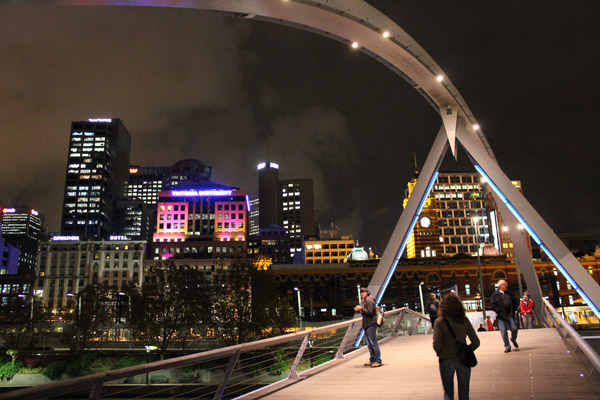
Crossing back over the Yarra.

One of Melbourne's busiest intersections.
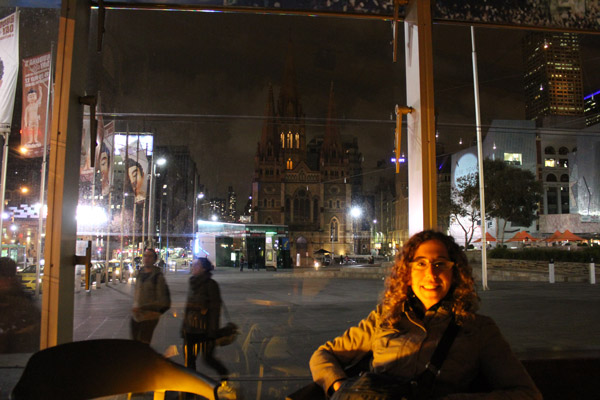
Having a drink at Transport Bar.
We had a few hours left on our day, so we decided to get the lay of the land in the most efficient way possible. We took a foot bridge over the Yarra and shuffled a few blocks to the Eureka Tower -- the tallest building in Melbourne, and one of the tallest residential structures in the world. If you ask nicely, flirt with the girls at the front desk, and then pay the admission fee, they'll let you go to the observation deck on the 88th floor.
A lot of travel involves trying to see things from different perspectives, and not in a metaphorical sense. It's peculiar, because you can't do anything with a view other than look at it. Just about every building, forest, mountain, canyon, stadium or park is far more interesting at ground level, where it can be touched and experienced and absorbed in an intimate and memorable way. But ground level doesn't do it for the human spirit, which is why I have photos of the Sydney Opera House from the top of a bridge, from both sides of a harbor, from a boat in the harbor, from two different piers, and from a botanical garden. Eighty percent of those were taken after we had already been inside, and as we left Sydney, I still had the nagging feeling that I hadn't taken enough photos of the Opera House.
Similarly, it's far more interesting to walk a city street, where life is all around you; on foot, you can widow shop at the sex toys store and smell the French fries stand on the corner, or smell the sex toys store and window shop at the French fries stand. But there is still some strange compulsion to see it from above, at a height where the details disappear. There's something reassuring about holding the high ground -- but as we had no immediate plans to invade or bombard Melbourne, I can't explain the precise value of a trip to the 88th floor.
Nonetheless, we went. By the time we reached the deck, it was night; we were viewing the city in all its electrified glory. The Eureka Tower dominates the skyline -- you're so high up, it's like looking at a map. We could see the central business district, the parks along the Yarra, the old Olympic facilities from 1956 and the Melbourne Cricket Ground. All those places were going to factor into our vacation, so it was like the visual overture to the final leg of our trip. There's probably a non-musical-theater analogy out there that makes me look far more manly, but I like overtures. They're catchy. Deal with it.
Most of Skydeck is indoors, but they are nice enough to provide an outdoor area so you can experience firsthand what the winds are like 88 stories above the street -- free of charge! After taking a few bird's eye photos of the city, we took advantage of a photo booth on the observation deck, then headed back to the street.
It was dinner time, and as you may recall we had a recommendation from a morbidly obese pitbull owner. The distance didn't seem too daunting, so we walked back across the Yarra and made our way to the Greek district. The heart of Melbourne has plenty of neon and music and activity, all through the night; there are street cars and sex shops and restaurants and clubs and young people everywhere. We had a good sense of it all by the time we reached Stalactite's, which was a perfectly serviceable dinner destination. I tried something like my 10th different Australian beer; Allyson had something that wasn't meat.
After dinner, we strolled through Chinatown, then ended up at the Transport Bar, at one of the most interesting intersections in the city. The bar sits on a plaza that includes the Australian Center for the Moving Image -- a very modern looking museum-type building. To the left, across Kilda Road, was the beautiful and ornate train station. Catty corner was Young and Jacksons, one of the older and more legendary bars in the city. And across Flinders Street is the enormous St. Paul's cathedral. It's all along the river.
Transport probably gets crazy if you're up late enough -- it seemed like it might be the kind of place where people in slim-fit clothing buy $15 mixed drinks and look for the most attractive person with no visible cold sores. It was quiet when we got there, and as grizzled old travelers we were happy to enjoy the view through its huge windows while it was quiet. After another fine Australian beverage, it was time to get back to the Rendezvous to scribble down some notes about our day.
We also had a big tomorrow ahead of us. We had really just gotten to Melbourne, and we had exciting plans to leave it as soon as possible.
